
9. X-Pigeons |
||||
ca - Cataract
 Normally
lenses of the eye, which acts like the lens on cameras, is clear, focusing
light
as it passes to
the back of the eye. When a cataract is formed, either by various
diseases, old age, or congenitally, the lens inside the eye becomes
cloudy producing blurry and decreased vision. Visual loss occurs
due to the opacification of the lens, which obstructs light from
passing and being focused on to the retina at the back of the eye.
Cataracts
are seen in a variety of organisms in the animal kingdom including
raptors, birds, and mammals. Although the incidence of cataracts
in cats is surprisingly low, dogs are commonly affected by cataracts,
particularly purebreds. Cataract occurs most commonly as senile
alteration in non-domesticated aged birds; in domesticated birds,
cataracts may
develop as a secondary
ocular lesion in infectious disease. In poultry, cataract has been
described in association with Marek’s disease, avian encephalomyelitis
or Salmonella arizonae infection. Cataracts have also been associated
with vitamin E deficiency in turkeys. “It is most
commonly due to ageing but there are a wide variety of other causes.
Over
time,
yellow-brown pigment is deposited within the lens and this, together
with disruption of the normal architecture of the lens fibers,
leads to reduced transmission of light, which in turn leads to
visual problems" (http://en.wikipedia.org/wiki/Cataract).
Normally
lenses of the eye, which acts like the lens on cameras, is clear, focusing
light
as it passes to
the back of the eye. When a cataract is formed, either by various
diseases, old age, or congenitally, the lens inside the eye becomes
cloudy producing blurry and decreased vision. Visual loss occurs
due to the opacification of the lens, which obstructs light from
passing and being focused on to the retina at the back of the eye.
Cataracts
are seen in a variety of organisms in the animal kingdom including
raptors, birds, and mammals. Although the incidence of cataracts
in cats is surprisingly low, dogs are commonly affected by cataracts,
particularly purebreds. Cataract occurs most commonly as senile
alteration in non-domesticated aged birds; in domesticated birds,
cataracts may
develop as a secondary
ocular lesion in infectious disease. In poultry, cataract has been
described in association with Marek’s disease, avian encephalomyelitis
or Salmonella arizonae infection. Cataracts have also been associated
with vitamin E deficiency in turkeys. “It is most
commonly due to ageing but there are a wide variety of other causes.
Over
time,
yellow-brown pigment is deposited within the lens and this, together
with disruption of the normal architecture of the lens fibers,
leads to reduced transmission of light, which in turn leads to
visual problems" (http://en.wikipedia.org/wiki/Cataract).
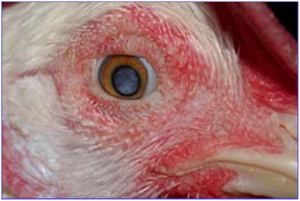 Cataract
in chickens is well documented. A study done by NC State University
College of Veterinary
Medicine, Raleigh, NC classified the cataract in
chickens by location: Nuclear-center of lens, cortical-outer edge of
lens, subcapsular-between fibrous capsule and lens epithelium. Other
than congenital
causes, this study also classified causes of cataract in chickens by
age, bacterial, fungal, nutritional deficiencies and viral. A
study done by Cornell University Hospital for Animals reveals that
blindness in some chickens is caused by cataract. This study has
found eye infections that went untreated can lead to cataract. According
to a study performed at the University of Florida, a high incidence
of cataracts can occur in flocks with vitamin
E deficiency, avian encephalomyelitis
infection, or continuous exposure to some types of artificial lighting. A
study conducted by University College, London found that a deficiency
of vitamin B2 regularly produced cataract in rats. However, since
the incidence of cataract in their experiments is relatively low,
it is concluded that the relationship of cataract to vitamin B2 deficiency
still remains obscure. Another study published by Avian Pathology
Journal found congenital cataract in 1-day-old French Mulard ducklings,
where in ducks ocular lesions are rarely reported and concern only
acquired disease.
Cataract
in chickens is well documented. A study done by NC State University
College of Veterinary
Medicine, Raleigh, NC classified the cataract in
chickens by location: Nuclear-center of lens, cortical-outer edge of
lens, subcapsular-between fibrous capsule and lens epithelium. Other
than congenital
causes, this study also classified causes of cataract in chickens by
age, bacterial, fungal, nutritional deficiencies and viral. A
study done by Cornell University Hospital for Animals reveals that
blindness in some chickens is caused by cataract. This study has
found eye infections that went untreated can lead to cataract. According
to a study performed at the University of Florida, a high incidence
of cataracts can occur in flocks with vitamin
E deficiency, avian encephalomyelitis
infection, or continuous exposure to some types of artificial lighting. A
study conducted by University College, London found that a deficiency
of vitamin B2 regularly produced cataract in rats. However, since
the incidence of cataract in their experiments is relatively low,
it is concluded that the relationship of cataract to vitamin B2 deficiency
still remains obscure. Another study published by Avian Pathology
Journal found congenital cataract in 1-day-old French Mulard ducklings,
where in ducks ocular lesions are rarely reported and concern only
acquired disease.
Photo courtesy of the pictures: The cataract chicken picture above: Deavers, M. & Barnes, J. DVM, North Carolina University. The cataract owl picture below is taken from davidlwilliams.org.uk. It seems to have bilateral cataracts. The second picture is a mature intumescent cataract in the right eye of a 12-year old diabetic American Eskimo dog. It is taken from www.vmcli.com. The Rabbit with cataract was taken from flikr.com posted by Olathe Animal Hospital in Olathe, KS. The Tiger with cataract eye picture is taken from tumblr.com posted by WITH 79 NOTES. Click on following pictures to enlarge them.
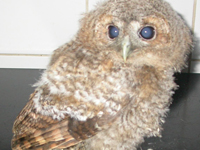 |
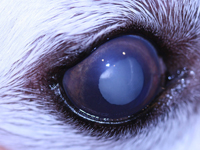 |
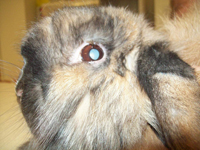 |
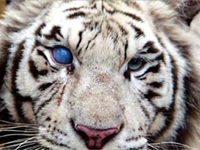 |
Although cataract in pigeons is also caused by variety of reasons, the hereditary cataracts in pigeons were first noticed by Carl Graefe in Show Racers. The only published data about cataracts in pigeons was reported by W.F. Hollander in the August 1958, American Pigeon Journal, Volume 47, page 248. The article was titled "Hereditary Cataracts in pigeons". This article dealt mainly in one family of Show Racers which were sent to Hollander by Graefe. According to Hollander the mutant is caused by a simple recessive gene, and therefore he proposed ca as the symbol. Hollander also reports that cataracts develops gradually, becoming obvious by the time the bird is sexually mature, and increasing to a complete inability to see more than darkness vs. light. Hollander said, young birds seemed normal, but cataract developed by maturity so that essential blindness resulted and the birds had to be fed in a bowl or cup. In addition, a less severe type of cataract has also been noted by Al Westling and others to occur in LFCL Tumblers occasionally (Hollander, Origins And Excursions In Pigeon Genetics, P.108-109).
Test results for hereditary cataract in Chickens, Turkeys, and Ducks proves that recessive sex-linked is the cause of this mutant. According to Hollander’s report however, it is a simple recessive gene in Pigeons. Although it sounds strange why pigeons would have this mutant in their autosomal chromosomes, we have to realize that pigeons have long been distinct from fowl - chickens, ducks, geese, pheasants, quails, partridges, and turkeys. Therefore, even if the hereditary pigeon cataract and those in other birds all came from the same original mutant, it is always possible that pigeons have undergone some chromosomal rearrangement over the course of evolution that moved it off the sex chromosome.
References:
1. Bourne, M.C. & Pyke,
M. A. (1935). CCXVII. The Occurrence of Cataract in Rats Fed
on Diets Deficient in Vitamin B2. Department of Physiology
and Biochemistry, University College, London.
2. Deavers,
M. & Barnes,
J. DVM. Cataracts in Two Unrelated Chicken Flocks. NC
State University, College of Veterinary Medicine, Raleigh,NC
3. Hollander, W. F. (1983). Origins And Excursions In Pigeon Genetics:
A Compilation. Burrton, Kan.: The Ink Spot.
4. J.P. Jacob, G.D. Butcher and F.B. Mather. Eye Disorders of Poultry.
Animal Sciences Department, Florida Cooperative Extension Service,
Institute of Food and Agricultural Sciences, University of Florida,
PS37.
5. Wikipedia. Cataract. Retrieved January 21, 2013, from http://en.wikipedia.org/wiki/Cataract
Copyright January, 2013 by Arif Mümtaz.